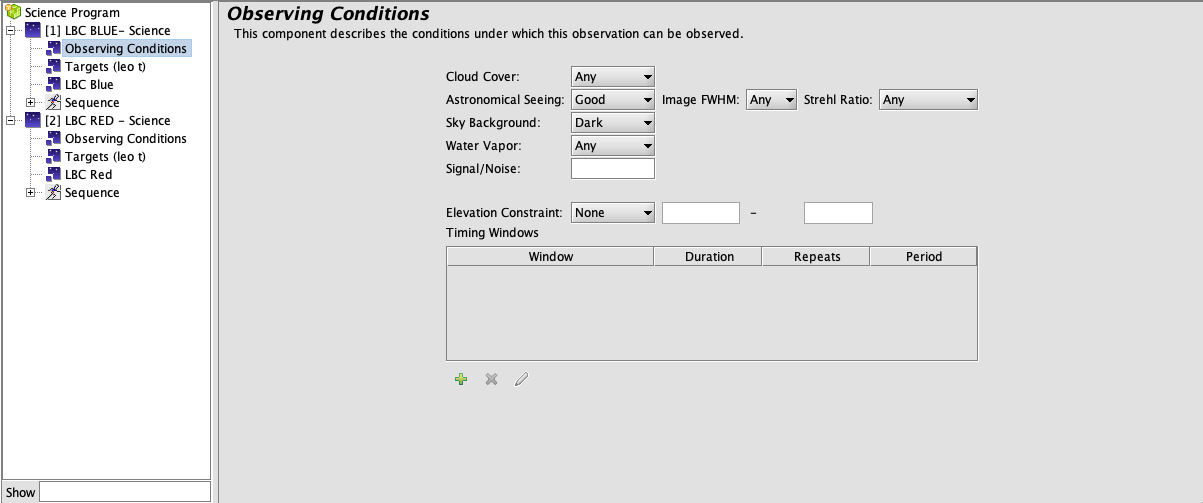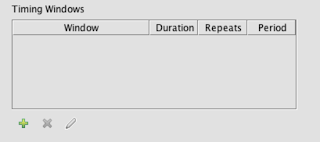Observing Conditions

The Observing Conditions Element is used to define the observing constraints for an observation. Selecting this component in the science program viewer displays the four weather constraints (image quality, sky background, cloud cover, and water vapor) as well as new elevation and timing window constraints in the editor.
As of OT 2022B+, users executing AO observations can define Strehl and/or FWHM Constraints. This mimics the definitions provided in the PIT. Users can also indicate a SNR. This helps observers at the time of execution meet the scientific needs.
Observation Conditions

Using the drop down menus provided PIs can select the observing conditions necessary for science: cloud cover, astronomical seeing, sky brightness, and water vapor. Below is a key to guide your selection of conditions for each constraint. These conditions will only be used as rough guidelines for partner service observers and PIs and are not guaranteed constraints.
AO users, please see the AO guidelines to determine selections for the Seeing, Cloud Cover, and Background, and to learn other information related to AO observations.
| Cloud Cover | Constraint | ||||
| Clear | Cirrus | Variable | Cloudy | Any | |
| Qualitative Description | No clouds visible | Thin clouds visible | Variable guide counts; Guiding and WFS still possible | Visible thick clouds; Guiding still possible. WFS may or may not be possible | Visible thick clouds; guiding and WFS not possible (track only) |
| Astronomical Seeing | Constraint | |||
| Best | Good | Poor | Any | |
| DIMM/GCS | < 0.8 | < 1.00 | < 1.20 | > 1.2 |
| Sky Background | Constraint | |||
| Darkest | Dark | Grey | Any/Bright | |
| Qualitative Description | Moon below horizon. | Full/Gibeous moon near horizon
Crescent moon between horizon and zenith |
Full/Gibeous Moon above horizon
Quarter moon close to target (<20 deg) Within an hour of astronomical twilight |
Full Moon near target (< 20 deg)
Astronomical twilight |
| Water Vapor (mostly LBTI) |
Constraint | |||
| Low | Median | High | Any | |
| < 3 mm | 3-5 mm | > 5 mm | NA | |
Elevation Constraints
In general, service observers and classical observers strive to observe all objects at airmass < 2.0 and no *additional* elevation constraint is required. This default is assumed to maximize schedulability of targets. However, when the science demands it, PIs may add airmass or hour angle constraints by using the Elevation Constraint drop-down menu and then entering appropriate values in the boxes to the right. Use of these constraints should be checked with the partner coordinator before proceeding, especially if the PI did not ask for such constraints in his/her proposal. Also, be sure to use the elevation plot feature to check that the requested constraints are reasonable and allow the observation to be scheduled.
These elevation constraints will only be used as rough guidelines for partner service observers and PIs and are not guaranteed constraints unless previously specified by the partner.
Timing Windows

The Timing Window Constraints can be added for any observations that must be observed at particular times. Timing window can be added by clicking the Add icon (green plus sign) below the Timing Windows box. Another window will pop up in which the starting UT date and time, the window duration, and whether the window repeats and with what period. Multiple sets of timing window scan be entered.

For the example given below the observation has the chance to be scheduled in the following time windows:
2016-10-16 23:00:00 to 2006-10-17 00:00:00
2016-10-17 01:00:00 to 2006-10-17 02:00:00

The timing windows are the periods when the observation can be scheduled. An observation will only be scheduled in one of these windows at a time until it is observed. If an observation can only be done at one time, then the window should not repeat. A given observation will only be observed in one of the timing windows. Therefore, monitoring programs will need separate observations defined for each repeat visit.
If any observation within a scheduling group has timing constraints, then the constraints apply to the entire group. If observations within groups have different constraints, then the most restrictive set is used.


